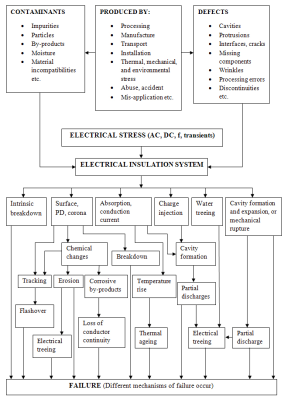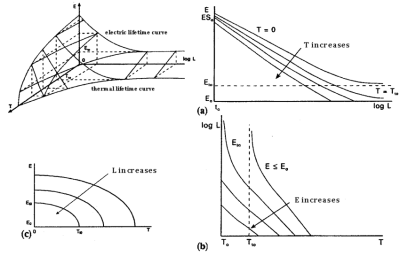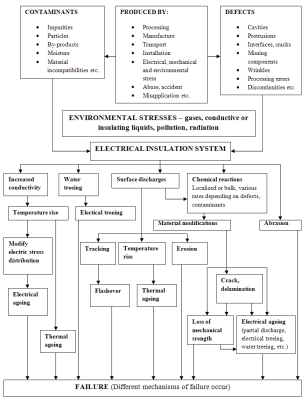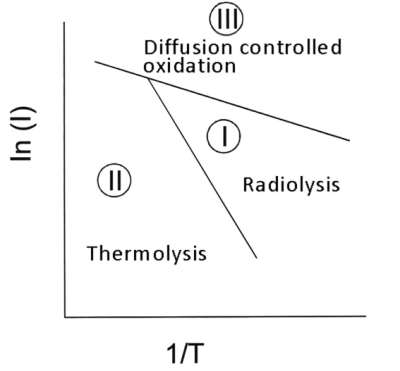Electrical insulation system ageing caused by electrical, multifactorial and environmental stresses
12. Jún, 2013, Autor článku: Váry Michal, Elektrotechnika
Ročník 6, číslo 6  Pridať príspevok
Pridať príspevok
![]() This contribution deals with the negative effects of electrical, combined electro-thermal and environmental stresses acting on the electrical insulation system. These stresses causes the electrical insulation system degradation and ageing. More detailed the electrical stress, related accelerated electrical ageing procedures and the combined electro-thermal lifetime relationships are described. In this paper we only briefly mention some significant environmental degradation factors. Flowcharts mentioned in the contribution showing the processes of ageing leading to failure.
This contribution deals with the negative effects of electrical, combined electro-thermal and environmental stresses acting on the electrical insulation system. These stresses causes the electrical insulation system degradation and ageing. More detailed the electrical stress, related accelerated electrical ageing procedures and the combined electro-thermal lifetime relationships are described. In this paper we only briefly mention some significant environmental degradation factors. Flowcharts mentioned in the contribution showing the processes of ageing leading to failure.
Electrical stress and ageing
Electrical stress degradation mechanisms of electrical insulation material or system are very complex phenomena. There have not been well-defined accelerated ageing test methods to determine electrical insulation lifetime yet, similar to analytical techniques for thermal ageing. But there are a well established working procedures rather, based on some empirical knowledge [1,2], [3-6]. It is important to recognize, that negative electrical ageing effects are strongly dependent on the nature of electrical insulation system (EIS). Variables and aspects, which are often important, include electrodes size, insulation thickness, stresses rate, absolute applied voltage intensity and frequency, failure probability rate and its changes. Generally, alternating, direct or impulse electrical ageing involves (Fig. 1) [8]:
- the effect of partial discharges when the local field srength exceeds the breakdown strength in the liquid or gaseous dielectric adjacent to, or included in, the electroinsulating system (EIS),
- the effect of tracking,
- the effect of treeing,
- the effect of electrolysis,
- the effects, related to those above, on adjacent surfaces of two insulating materials where tangential fields of relatively high value can occur,
- the effect of increased temperatures produced by high dielectric losses,
- the effect of space charges.

Figure 1: Electrical ageing (according to STN EN 60505 [8]).
Electrical stress is usually considered the ageing factor, if are present external or internal partial discharges, or their generation during operating voltage are expected. Electrical discharges presence at overvoltages can be taken into consideration, when these overvoltages occur in operation frequently. Technical considerations based on Paschen phenomenon, insulation system geometry, insulation material permittivity and gases density in pores or on electrical stressed surface can provide access to possible existence of partial discharges predestination. Partial discharges amplitude and time distribution recording is a powerful diagnostic tool. These distributions comparing at tested and operated electrical stress levels can provide valuable information of investigated object ageing state. If above certain voltage level will appear partial discharges with amplitudes significantly higher than in operating conditions, have to be validity of these test results carefully reviewed.
Increased voltage has different effects in different conditions. In a small cavity will not change partial discharge pulses amplitude and affected area size, but a number of pulses per time unit will change gradually. In a gap of constant thickness can not the size of pulses up to a certain voltage limits significantly change, but will change the geometric distribution of pulses. Flat thin cavity interface can be significant exposed to discharges as the cavity core. In irregular cavities are various areas exposed to different voltages. Individual discharges can alter character of increased secondary tangential discharges. Is known that in some cases partial discharges with low-amplitude can have significant degradation effect in comparison to effects of large discharges, depending on the medium, in which they appear. Currently, partial discharges observation correlates, is associated with tree phenomenon. Another approach consisting of these discharges measurement by properly chosen method as described in IEC 60270: Partial discharge measurements or for short rise time and fast repetitive impulse voltages IEC 61934: Electrical measurement of partial discharge under short rise time and repetitive voltage impulses.
In some cases, electrical ageing can be detected during tests, in which the presence of partial discharges is not reflected. Ageing effects caused by other electrical stress aspects, such as tree phenomenon, insulation surface break caused by surface discharges, electrolytic effect (in terms of increased temperature and humidity can cause to electrolytic degradation), generally cannot be determined by simple, non-destructive measurements of the insulation system. Specific degradation mechanism was also observed by action of space charge in presence of direct voltage [9-11]. It is possible that electrical stresses become ageing factor only in presence of other factors or secondary to their impact (such as temperature and humidity or mechanical stress). These other factors modify system properties, either reversible or an irreversible ways. In this case must be electric stress take into consideration, even if it does not cause ageing without action, whether concurrent or not, of these other factors.
Accelerated electrical ageing procedures
Accelerated electrical stress tests are usually realized by (as in the case of conventional thermal ageing test methods) performing lifetime tests at electric field values above planned operational insulation system values. To achieve the correct showing the results in E – L chart is desirable to obtain at least three and preferably four points. Electrical stress levels used for accelerated ageing cycles have to be based on at least two equivalent ageing intervals. Selected voltage should be in such proportion that the ratio of highest and lowest lifetime is about 1000:1. In ageing program is to be used lowest accelerated ageing level, which reaches test subject failure point for a minimum of 5% of expected insulation system lifetime. The next higher stress level is to be derived from slope and shape of lifetime curves.
If it is not possible to determine test voltage value in advance for selected lifetime, it is necessary to determine the voltage V1, V2, V3 and V4 (in case of using four test voltages, if the lifetime for these voltages can be estimated). Ratios V2/V1, V3/V2 and V4/V3 are to be fixed by experience or from previous measurements on similar systems containing specified type of tested insulation. For example, can be chosen quotient V2/V1=V3/V2 =V4/V3=1.2. Similarly, the ratio of lowest test voltage V1 to operating voltage V0 can be chosen from experience and/or from previous tests. Accelerate the ageing can be also achieved by increasing test voltage frequency, but the relationship between lifetime and increased test voltage frequency is still one of the open questions. It can be assumed that depending on predominant degradation mechanism, can this dependency consist of the ratio of testing voltage frequency ft to operating voltage frequency f0, amplified by exponent, in some cases approaching to 1. Dielectric losses, which increase with frequency, should not significantly influence sample temperature. It is important to monitoring this temperature.
To accelerated ageing, whether by the action of increased voltage levels or by increased frequency, can accede only after careful study and demonstration of validity of this approach. Experience shows, that some insulation systems cannot be subjected to accelerated ageing tests at frequencies higher than a few hundred hertz, while others provide very good results, when exposed to frequencies of the order of kilohertz. At the present knowledge stage and network frequency at 50 Hz it seems appropriate not to expose investigated objects to frequencies higher than 1000 Hz without a thorough examination of consequences. In some cases it is recommended to perform these accelerated tests at elevated level of applied voltage and network frequency. Electrical ageing procedure consists of continuous or periodic model (or device itself) exposure to controlled electrical stress. Diagnostic factors can be applied continuously or periodically to test object to assess the changes of relevant properties. The endpoint criterion may be:
- failure at test voltage,
- failure at overvoltage, that can be applied periodically,
- achieving a defined level of diagnostic factor.
In most cases the applied voltage must be maintained in range of ±2% from selected level with a short-term changes ± 5% (less than ± 5% of testing time). The main parameter needed to characterize electrical durability is a VEC (voltage endurance coefficient – n in equation (1)) related to lifetime directive lines at accelerated electric degradation. Another important parameter is threshold electric field intensity, below which electrical ageing effect becomes negligible. Given material electric strength value, its temporal variation can be main indicator to assess ability to resist electrical voltage and can be taken into consideration to assess the electrical ageing effects. VEC coefficient and threshold electric field intensity are determined by long-term lifetime tests, although some studies have shown possibility to estimate these parameters in a relatively short test times.
For the experimental data extrapolation purposes and obtaining the lifetime related to electrical stress are used simplified electrical ageing models (1, 2). Bellow electrical ageing models describe the ageing of any material, that is exposed to an electrical stress (AC, DC) and also to the electrical stress originating from repetitive impulse voltage. According to [8,15] the inverse power model is defined as:
| (1) |
and exponential model:
| (2) |
, where L is lifetime [h], E is electric field intensity [kV.mm-1], a,k,b,n are constants determined empirically.
Combined electro-thermal stress
During the current action of electrical and thermal stress (multifactorial stress) isolation system fault comes mainly due to electrical stress (electric breakdown), while the effect of thermal stress can significantly contribute to shorten lifetime due to insulation thermal degradation [16, 17]. Therefore, the parameters characterizing multifactorial stress are voltage endurance coefficient VEC, contributed to lifetime directive lines under accelerated electric degradation, threshold electric field intensity value (in this case, these parameters are temperature-dependent) and quantity so called a “stress compatibility index” SCI, which synergistic effects between operating factors includes. Operating factors superposition generally causes synergistic effects and increases ageing rate, reduces material lifetime, resulting in final degradation rate and is higher than simple degradation speeds amount corresponding to different ageing stresses. Therefore, test times can be significantly shorter than at room temperature. This allows lifetime tests performance at factors stress levels close to operational conditions of given materials.
Electro-thermal lifetime modeling problem have been extensively studied in the seventies and eighties of the last century also based on the Eyring law or on modifications of thermal and electrical endurance models. The key to electrothermal model formulation was thorough understanding of model parameters based on two independently changing degradation factors – electric field and temperature. Otherwise, electrical lifetime model can be used to experimental lifetime tests data evaluation at selected temperature at different electric field and so it applies to thermal lifetime models. Another important aspect is introduction of additional relations characterizing synergistic phenomena between thermal and electrical stress. Endicott explained the dependence of thermal reaction rate as a function of electrical stress (similar approach applies to mechanical stress) reformulation of Eyring equation in the form:
| (3) |
,where S is the stress (electrical or mechanical), k1, k2, k3 are constants independent of time, temperature and stress, the exponent w ≈ 1. If f (S) = 0, equation (3) takes equation form for thermal lifetime, that differs from equation (3) only by pre-exponential Tw element, but in the Eyring thermal ageing model form. If T is constant and S = E (electric stress), equation (3) takes the form:
| (4) |
,with coefficients h = k2 + k3/T a C/ = k1Tw. If we put f(E) = E, we get an exponential model for electrical stress (for f(E) = log [E] we get an inverse power model). Therefore, equation (4) is a fundamental electrical insulation lifetime relationship for material or system as a function of temperature and/or electrical stress. It should be noted, that this equation is multiplicative, thermal and electrical stress velocity is multiplied to reach final combined stress velocity. It is also taken into consideration temperature dependence of electrical resistance coefficient VEC. Simoni later preformed the given equation and appropriate boundary conditions took into consideration. The model is described in the form:
| (5) |
,where E/ is the electrical stress, defined as E – E0, or log[E/E0], according to the chosen electric lifetime model, exponential, respectively inverse power model. TC is thermal stress, defined as TC = 1/T0 – 1/T, where T0 is temperature, below which can be the thermal ageing influence neglected (often room temperature). This model provides four factors that serve to characterize the multifactorial electro-thermal insulation resistance. Coefficient B for thermal stress, h for electrical resistance, b characterizes the degree of operating factors synergism and L0 the normalization (scaling) parameter. This model has been successfully used to evaluate the experimental data of several insulating materials. Lifetime characteristics consists of three-dimensional lifetime surface in the multifactor stress case. In the case of multifactorial threshold stress model is the shape of surface shown in Figure 2 and provides the following points of intersection with different surfaces identified by axes E, T, L [18].
- at a constant temperature T, electrical lifetime characteristics at different temperatures
(Fig. 2 a) - at a constant electric field E, thermal lifetime characteristics at different intensities E
(Fig. 2 b) - for a constant life period L, isochronal lines ( E-T ) ( Fig. 2 c )
Among last mentioned characteristic type have special position threshold lifetime line. Position setting of this curve is essentially one of the main goals of multifactorial endurance stress tests.

Figure 2: Modification of 3D lifetime surface so called “threshold” models [18].
Environmental stresses and ageing
This type of stress includes effects of moisture, atmospheric oxygen, chemical, biological and climatic effects, impurities, increased pressure, vibration and radiation environmental conditions. In this work we only briefly mention some significant environmental degradation factors. Ageing caused by environmental stresses processes involves chemical reactions mentioned in thermal ageing. Surrounding environment factors can in different ways also affect type and degree of degradation caused by another stress, which is EIS exposed to. Another important aspects are stress distribution change caused by changes in surrounding environment and impact of dust and other contamination to electrical behavior. If these data will not be available, only acceptable procedure is to use the most severe environmental conditions in operation during ageing sub-cycle.
For environmental ageing (Fig. 3) may be present different mechanisms and are no general models. Currently, there are no documented general rules for implementation acceleration factors into relation to ageing by action of ambient environmental influence. Only when environmental stresses affect chemical reaction rates, then the thermal ageing model and the Arrhenius equation may be used [8, 19].

Figure 3: Environmental ageing (according to STN EN 60505 [8]).
Humidity:
Chemical reactions in progress between water ions and insulation (hydrolysis) may lead to insulation destruction. Insulation mechanical properties can disrupt with moisture. Electrical properties with moisture absorption changing significantly (material dielectric strength significantly change, dielectric losses increase, electric stress structure redistribution). This leads to sparkover, to insulation surface breach due to partial discharges followed by erosion of insulation surface. Synergistic effects may occur between an electric field and humidity, which can lead on some polymers to creating water trees. Dynamics of condensation, capillarity and absorption and resulting material changes depends on exposure to moisture mode (steam or liquid). Condensation also depends on the temperature change rate and is usually achieved by cyclic procedures. If the test object contains a water-soluble components, humidity exposure changing material sample structure.
Atmospheric oxygen:
Mechanical and electrical polymeric materials properties can deteriorate by action of oxidation accelerated by high temperature or ultraviolet radiation. Generally, oxidation determines changes starting at surface, some materials are prone to hardening and others to softening and some demonstrate initial hardening followed by softening. These are irreversible processes. The degree of oxidation is affected by factors such as the type of polymer, type and density of cross-links, content of additives (antioxidants, fillers).
Radiation conditions:
Radiation represent very specific and severe environmental conditions for electrical insulation. It includes the impact of charged corpuscle and electromagnetic radiation effect. These factors usually cause physical properties degradation and change. Radiation transition through substance occurs to its interaction with substance atoms, which transfers its energy to material [20]. This energy is consumed for ionization and excitation of substance atoms and molecules. Interaction mechanism of radiation with substance depends on internal material structure and type of bonds. Result of these interactions is to material electron structure change, formation vacancy defect type and interstitial disorders. Interaction of high-energy particles with grid atoms leads to generate grid vacancies. Reflected atom usually has enough energy to create additional vacancies. If ejected atom is captured to non-equilibrium interstitial position, there is interstitial defect type.
Solid substances are resistant to ionizing radiation depending on their internal structure variously. When high-energy ionizing radiation interacts with inorganic substances, most frequently occurs to crystalline structure distortions. This is reflected in worsening of mechanical – physical properties. Plastic materials are especially sensitive to radiation because in them is a covalent bonds distortion most frequently. The main properties change processes are degradation processes: cracking, condensation and polymerization. Mentioned processes (in particular polymerization and condensation) competing with each other. The resulting character of changes is determined by the chemical and structural composition of substance as well as external physical irradiation conditions. Changes in the polymers properties during irradiation significantly depend on chemical structure, phase state, type and amount of additives and fillers, size of irradiated systems as well as irradiation conditions, device type and of course a component and energy composition of radiation, total absorbed dose and dose rate, temperature, gas environment and pressure.
As a result of irradiation leads to changes in the polymers structure. High-energy radiation in substances such as plastics in general is less absorbed, but its effect is extremely aggressive. Quantum of ionizing radiation has generally more energy than is needed to remove an electron from one atom, but the greater part of it is converted into kinetic energy of released electrons, enough to split chemical bonds.
Part of the structural changes occurring only during irradiation and after irradiation occurs to resumption of the original structure. These changes give rise to generated electrical conductivity, which after irradiation gradually become extinct. Irreversible processes are caused by changes in irradiated system, which represent the following effects:
- crosslinking – formation of cross-links between molecules,
- destruction – tearing of the main chain of the polymer molecule,
- release of gases,
- formation intramolecular links,
- oxidation,
- polymerization.
All of these radiation-induced changes are reflected on external polymer appearance, its physical condition and mechanical properties. Polymers dimensions caused by radiation is changing. Due to irradiation of polymeric materials can occur to gases emissions. Material more susceptible to gases emissions changing properties at smaller radiation doses. Gas creation causes swelling of the polymer and density decrease. At continuous irradiation of polymers in which prevail crosslinking processes are generated three-dimensional crosslinked molecules with high firmness and stability. Destruction process raises contrary effects of irradiation. Radiation exposure results depend on polymer chain structure. Materials containing in main chain alternating one-fourth carbon atoms or carbon atoms that have in the role of deputy haloid atoms show a tendency to destruction. Polymers comprising at least a one hydrogen atom in vicinity of carbon, belonging to methylene group (-CH2-), shows a tendency to crosslinking. Polymers with high content of aromatic chains have high radiation resistance with high content of aliphatic structures with less resistance.
The resulting properties change effect is given by speed ratio above mentioned reactions depending on chemical nature of polymer structure with reaction conditions and radiation dose conditions. In presence of oxygen, oxidation reactions are still in progress, which can have for some types of plastic materials decisive impact. Greater molecular polymer weight accelerates polymer crosslinking (lower weight – slower crosslinking) and whole process depends on radiation energy. The presence of mechanical tensions under irradiation affects crosslinking and degradation speed ratio and affects crosslinks distribution and thus crosslinking structure. For example, mentioned degradation mechanisms due to radiation are characteristic for cable systems embedded in nuclear power plant reactor core.

Figure 4: Schematic diagram illustrating the dominant mechanism of ageing for different levels of dose rate I and reciprocal temperature 1/T [21].
As shown in the schematic diagram in Figure 4 [21], depending on temperature and the radiation dose, to which are these systems subject to, can be a dominant degradation factor elevated temperature, where degradation process is thermolysis (area II) or radiation, where there is radiolysis (area I). In this active nuclear power plant reactor area cable systems operate. After exceeding a threshold radiation dose rate occurs to destruction by diffusion controlled oxidation (region III) in a wide temperature range.
Acknowledgements
 This contribution is the result of the project implementation Centre of Competence in New Materials, Advanced Technologies and Energy, ITMS 26240220073 supported by the Research & Development Operational Programme funded by the ERDF. Supporting the research in Slovakia. The project is co-financed by EU funds.
This contribution is the result of the project implementation Centre of Competence in New Materials, Advanced Technologies and Energy, ITMS 26240220073 supported by the Research & Development Operational Programme funded by the ERDF. Supporting the research in Slovakia. The project is co-financed by EU funds.
References
- Verbich, O., Ovčiarik, M., Sulová, J.: Materiálové a konštrukčné riešenie vykurovacích káblov, EKT, 52, pp.8-15, Bratislava,1999.
- Plastics Europe: The Compelling Facts About Plastics, An Analysis of Plastics Production, Demand and Recovery for 2005 Europe, spring 2007.
- Myer, E.: Plastics Failure Guide: Cause and Prevention, Hanser/Gardner, 1996.
- Woebcken, W.: International Plastics Handbook for the Technologist, Engineer and User. 3rd Edition, Hanser/Gardner, 1995.
- HAWKINS, L., W.: Polymer Degradation and Stabilization, Springer-Verlag Berlin Heidelberg, Germany, 1984.
- Kelen, T., Ivan, B., Nagy, T. T., Turcsanyi, B., Tudos, F., Kennedy, J. P.: Polymer Bull., 1, 79, 1978.
- Norsk Hydro a.s., PVC and Environment, Oslo, 1992.
- STN EN 60505: Hodnotenie a klasifikácia elektroizolačných systémov. 2012.
- Matsusaka, K., Tanaka, A., Murakami, I.: Polymer Bull., 25, 1337, 1984.
- Titow, W. V : PVC PLASTICS, Properties, Processing a Applications, Elsevier science publishers LTD, England, 1990.
- Vinyl 2010: Progress Report 2007, Report on the Activities on the Previous Year, 2007.
- Čaučík, P., et al.: Prísady do plastov, Vydavateľstvo technickej a ekonomickej literatúry, alfa, Bratislava, 1985.
- Vymazal, Z., Czakó, e., Volka, K., Štěpek, J.: Thermal Stabilisation of Polyvinylchlorid by Barium and Cadmium Stearates, Developments in Polymer Degradation – 4, Chapter 3, pp.71-100, APPLIED SCIENCE PUBLISHERS LTD, London, 1982.
- Lisý, J. .M., Rosenbergová, A., Adamčík, V., Oravec., A.: Vplyv zmesného olovnatého stabilizátora na kinetiku dehydrochlorácie polyvinylchlorid, Polyvinylchlorid a kopolyméry vinylchloridu, zborník prednášok, Odbor tlače a propagácie Slovnaft, pp.72-81, Bojnice, 1986.
- Mentlík, V. et al. Diagnostika elektrických zařízení. : In: BEN Technická literatura. Praha. ISBN 978-80-7300-232-9. 2008.
- G. Mazzanti, G. C. Montanari, L. Simoni: Insulation Characterization in multistress Conditions by Accelerated Life Tests: An Application to XLPE and EPR for HV Cables; IEEE Insulation Magazine; Vol. 13, No. 6, December 1997; pp. 24 –34.
- L. Simoni: A general phenomenological life model for insulating materials under combined stress; IEEE Transactions on Dielectrics and Electrical Insulation; Vol. 6 No. 2, April 1999; pp. 250 – 258.
- G. C. Montanari, G. Mazzanti, L. Simoni: Progress In Electrothermal Life Modeling of Electrical Insulation during the Last Decades; IEEE Transactions on Dielectrics and Electrical Insulation; Vol. 9, No. 5, December 2002; pp. 730 – 745.
- IEC 61359; Evaluation and identification of EIS – Environment evaluation; 1995
- Koutský, J., Kočík, J.: Radiation Damage of Structural Materials, Academia Prague, 1994
- International Atomic Energy Agency: Assessment and Management of Ageing of Major Nuclear Power Plant Components Important to Safety, In-containment instrumentation and Control Cables, Volume I, December 2000.
Coauthor of this paper is Eduard Firický, ÚEAE OMAT FEI STU Bratislava, Ilkovičova 3,812 19 Bratislava

